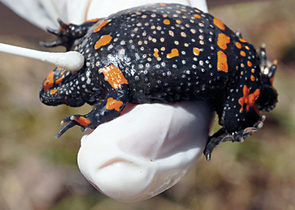Nature Conservation 4/2010 — 14. 9. 2010 — Research, Surveys and Data Management — Print article in pdf
Chytridiomycosis, a Threat to Amphibians in the Czech Republic?

Chytridiomycosis is an infectious disease of amphibians, caused by the chytrid Batrachochytrium dendrobatis, a non-hyphal zoosporic fungus. Chytridiomycosis has been linked to dramatic population declines or even extinctions in amphibian species in some worlds regions.
In the Czech Republic, the disease probably occurs on a large scale, similarly to other countries where its presence has been confirmed. By this time, no sharp population declines or extinction of the whole species, caused by an unknown driver, have been revealed in amphibians in the country. The disease has been recently reported from three amphibian taxa, namely water frogs of the genus Pelophylax andthe Common Toad (Bufo bufo) in Prague and the Fire-bellied Toad (Bombina bombina), inhabiting a brown-coal mine spoil bank in northern Bohemia. In 2008–2009, the Smooth Newt (Triturus vulgaris) and Great Crested Newt (Triturus vulgaris) were also sampled and no chytrdiomycosis was found in individuals tested. Even Fire-bellied toads infected did not display clinical symptoms of the disease. It seems that amphibians in the temperate zone are more able to suppress or at least not support chytridiomycosis growth than those inhabiting tropics or subtropics. Nevertheless, it is necessary to experimentally test the vulnerability of amphibian species occurring in the Czech Republic to the disease and consequently, to target conservation measures at those being more urgently at risk.

